#220f
Text
Iam a hot dude 🔥
With cool attitude ❄️

0 notes
Photo

Restart the Game ➖➖➖➖➖➖➖➖➖➖➖➖➖ @swagywanderer #swagywanderer ➖➖➖➖➖➖➖➖➖➖➖➖➖ #220f #pulsar220 #advlife #mototouring #photography #adventure #adventurerider #motoadventure #offroadlife #motorcycle #bikeride #bikersofinstagram #treasure #instamachines #exploretheunknown #adventureisoutthere #goexplore #goeverywhere #ridehard #ourplanetdaily #stayandwander #beautifuldestinations #mountainslovers #roamtheplanet #bikergram #instatravel #view #roadtrip #solotravel https://www.instagram.com/p/CiZCAbGhZ_d/?igshid=NGJjMDIxMWI=
#swagywanderer#220f#pulsar220#advlife#mototouring#photography#adventure#adventurerider#motoadventure#offroadlife#motorcycle#bikeride#bikersofinstagram#treasure#instamachines#exploretheunknown#adventureisoutthere#goexplore#goeverywhere#ridehard#ourplanetdaily#stayandwander#beautifuldestinations#mountainslovers#roamtheplanet#bikergram#instatravel#view#roadtrip#solotravel
0 notes
Text
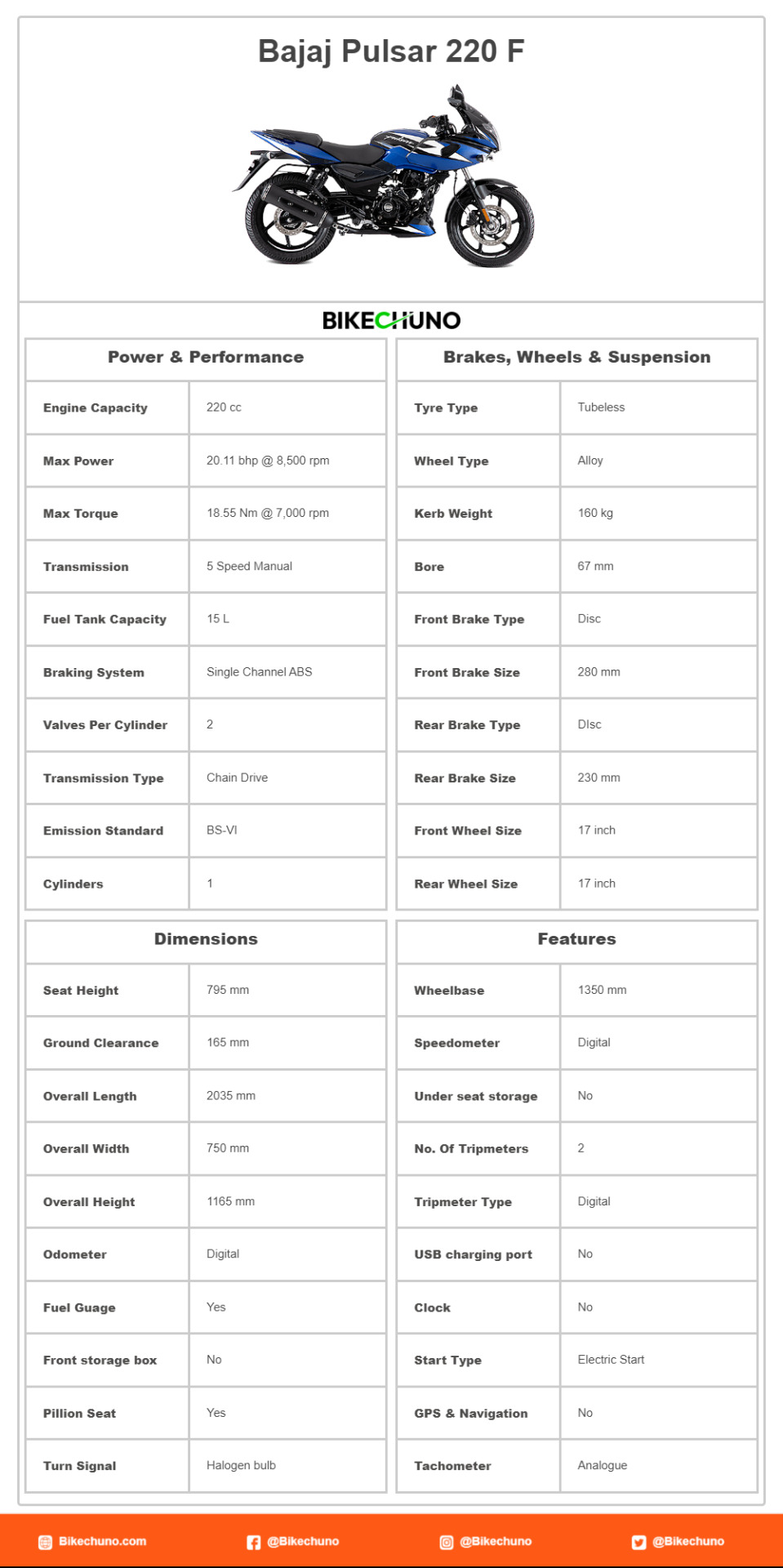
Get detailed information about the Bajaj Pulsar 220 F, including its specifications, features, ex-showroom price, performance, and mileage. Visit Bikechuno.com for more details.
0 notes
Text
भारत में बहुत जल्द फिरसे लॉन्च हो सकती है Pulsar 220F, इसमें है सुपर बाइक्स जैसे फीचर्स

Pulsar 220F: भारत में बजाज की पल्सर सबसे ज्यादा बिकने वाली बाइक में से एक है वही कुछ सालों पहले बजाज में अपनी बाइक पल्सर 220f की प्रोडक्शन बंद कर दी थी लेकिन भारत के लोगों को यह बाइक काफी ज्यादा पसंद थी इसीलिए इस बाइक की काफी ज्यादा डिमांड रखी जा रही थी।
इसीलिए लोगों की इतनी ज्यादा डिमांड को देखते हुए बजाज कंपनी इस बाइक को बहुत जल्द भारत में फिरसे लॉन्च कर सकती है लेकिन अभी कंपनी की तरफ से इस बाइक की लॉन्चिंग के बारे में कोई भी जानकारी नहीं दी गई है लेकिन आने वाले कुछ महीनों के अंदर भारत में यह बाइक लॉन्च हो सकती है।
Pulsar 220F के टेक्निकल स्पेसिफिकेशन्स
इस बाइक में 220cc का फ्यूल इंजेक्टेड सिंगल सिलेंडर डीटीएसआई इंजन का इस्तेमाल किया गया है
यह बाइक 20.9 बीएचपी की पावर और 18.5 एनएम की टोर्क को जनरेट करने की क्षमता रखती है
Pulsar 220F में 6 स्पीड गियरबॉक्स दिया गया है
इस बाइक की टॉप स्पीड 136 किलोमीटर प्रति घंटा है
इस बाइक में 15 लीटर का फ्यूल टैंक दिया गया है
Pulsar 220F की कीमत
आपको बता दे कि वर्तमान समय में बजाज की पल्सर 220F की प्रोडक्शन पूरी तरह से बंद कर दी गयी है लेकिन पहले जब भारत में यह बाइक बेची जाती थी तब इस बाइक की एक्स शोरूम कीमत 1.31 लाख रुपए थी इसीलिए यदि यह भारत में फिरसे लॉन्च होगी तो इसकी कीमत में ज्यादा बदलाव देखने को नहीं मिलेंगे।
यह भी पढ़े:- भारत में लॉन्च हुई RoadRunner Pro इलेक्ट्रिक स्कू��र एक बार चार्ज करने पर चलेगी 80 किलोमीटर
0 notes
Link
#A&O#AQ185720#ALPHA&OMEGA#ALPHA&OMEGASEMICONDUCTOR#AOTF8N65#GN6Y1R#N-ChannelMOSFET#N-ChannelMOSFET650V8ATO-220F#Q185720#TF8N65#TO-220F#TO220F#Transistor#TransistorMOSFET#TransistorN-ChannelMOSFET
0 notes
Text
Everything you need to know about Bajaj Pulsar 220F

The new Bajaj Pulsar 220 was introduced in the market on 2016. 220F motorbike has received many improvements and advancement since then. Pulsar 220F has become more stylish and improved its built quality over these years. Bajaj has added variations of color options and advanced the engine quality as well. The bike has made its reputation quite well in Nepali market. Today, with the support and love of all Nepalese Bajaj Bikes are built in Nepal at Hulas Auto Craft.
Specs/Built
The Pulsar 220F is an economical four-stroke motorcycle with a DTS-I, oil-cooled, single-cylinder powerplant. The engine has a capacity of 220 cc and produces a maximum power of 20.65 bhp at 8500 rpm and a maximum torque of 18.55 Nm at 7000 rpm. The front of this bike is equipped with telescopic forks. The rear of the bike has a 5-step adjustable nitrox shock absorber for good support and balance while riding on the road.
Design/Style
The bike features athletic appearance and can provide a performance-ready bike for those who have helped it become a cult classic over the years. Vertical dual headlamps, a matte black exhaust muffler, and reflective strips on the wheels distinguish this bike from earlier models. The instrument cluster is surrounded by faux carbon fiber and includes a backlit display.
Arrival
We have Bharat Stage (BS4) model in Nepal and official launch date of Pulsar 220F BS6 model is yet to be announced.
Comparison (Pulsar 220F ABS and Non-ABS)
ABS
Abs in bikes adds and extra feature, which comes in really valuable in busy roads when you need timed braking but there is a difference in price. (Click for - Price of Pulsar 220F ABS in Nepal)
Non-ABS
If you are not an aggressive rider and you are looking for optimal power performance for you preferred use, not choosing abs isn’t going to affect you in the long run. (Click for - Price of Pulsar 220F in Nepal)
Reasons why 220F is Popular Bike in Nepal in all age group
1. Performance with mileage: When you are unsure about your usage but you still want a strong bike to travel around and be economical.
2. Looks and Design: The bike is comfortable to sit on not just for the rider but also for the person in the back seat. The design is very slick and comes in various color.
3. Power: Obviously Pulsar 220 is more powerful, the acceleration on this bike can be really felt and followed by proper braking technology. Picking up speed and decelerating feels natural.
4. Fuel Tank: 15 liters tank, which is enough for the streets of Nepal or even going on a long tour.
5. Stability: Cross winds have a minimal impact. On highways, it's really stable.
Frequently Asked Questions On Bajaj Pulsar 220 F:
1. What is the city Mileage of Bajaj Pulsar 220 F in Nepal?
The city Mileage of Bajaj Pulsar 220 F is 40 Kmpl.
2. What is the Power of Bajaj Pulsar 220 F?
The power produced by Bajaj Pulsar 220 F is 20.93 PS @ 8500 rpm
3. What is Bajaj Pulsar 220 F Top Speed?
Bajaj Pulsar 220 F has a top speed of 136 Kmph.
4. What are different variants for Bajaj Pulsar 220 F?
The different variants of Bajaj Pulsar 220F are Bajaj Pulsar 220 F ABS & Bajaj Pulsar 220 F Non ABS.
5. What is the Tyre Type of Bajaj Pulsar 220 F?
Bajaj Pulsar 220 F has Tubeless tyres.
Source: Everything you need to know about Bajaj Pulsar 220F
0 notes
Text

Swirly Whirly's hair texture is SO bad that I had to get out the old iron, too, to see if it was the hair or the new iron. It's the hair.
It's been flattened 3 times and is on it's third conditioning right now.

Have to wash, condition, flat iron Shimmer Locks hair now to get it nice and smooth. Accidental aesthetic swoosh?

I was curious what happens if you flat iron Perfume Puff hair and its...... not much, actually.
Single pass at 220F without having been conditioned. The mane is super dry and crispy and was also severely matted. I've given her some conditioner and will try again later, just to see how smooth I can get it and how different the fiber is from standard nylon in the end.
5 notes
·
View notes
Text

It’s winter, and around here that means citrus season! Many of my neighbors are giving away fruit. I just picked up a bag of tangerines, still wet from the rain. To make room for them it’s time for a batch of Fruit Bowl Marmalade!
Fruit Bowl Marmalade is the easiest marmalade I know how to make. Start with whatever dry, sad citrus you have in your fruit bowl. If you like you can use good fruit, but you don’t have to. Combine with sugar and water, boil it up to 220F/104C, and you have marmalade!
The proportions are 1 kg fruit : 900 g sugar : 800 g water. If you have a scale but no metric (at which point I’m imagining you using an old fashioned weighted balance) then try 30 oz fruit, 27 oz sugar, and 24 oz water.
Slice your oranges (with whatever limes, lemons, or other citrus is in your bowl) into thin slices. You can use your favorite knife, but I use the slicing disc on my food processor because it’s fast and easy. Then put them in a big pot with the sugar and water. I started out using my pasta & stews pot but now I have a jam pan (very fancy!). Cook it until it’s nice and thick. If you have a thermometer aim for 220 F or 104 C because the sugar sets nicely at that temperature, but this is chunky marmalade and as long as it seems thick enough it will still taste good on toast.
I’ll probably can some of this in a boiling water bath for 10 minutes, but marmalade keeps beautifully in the fridge so you can skip that step if you’d like and just put it in jars.
And hey presto! You’ve gone from a fruit bowl of sad citrus to several jars of homemade marmalade. A magical transformation from almost-compost to preserves that may impress your friends!
2 notes
·
View notes
Text
Patio Special - 7-Up Chili-Burgers
Quick favorite recipes, distinctively different with…7up, the Seven Up Company, 1965.

Image Description:
[Patio Special - 7-Up Chili-Burgers
1 tablespoon shortening
1 pound ground beef
¾ cup chopped onion
1 teaspoon salt
½ teaspoon chili powder
1/8 teaspoon pepper
2 tablespoons flour
1 bottle (7 ounces) 7-Up
1 teaspoon Worcestershire sauce
¾ cup catsup or chili sauce
Melt shortening in automatic electric fry-pan set at 340F. Add meat and onions. Cook until meat is lightly browned, stirring as needed. Drain off excess fat. Reduce heat to 220F. Mix salt, chili powder, pepper and flour together in a small bowl. Slowly add 7-Up, stirring until smooth. Stir into meat mixture along with remaining ingredients. Cover and cook about 10 minutes or until desired consistency. Spoon on toasted buns. Makes 6 servings. Excellent cooked in heavy skillet over glowing coals.]
2 notes
·
View notes
Photo

My parents had a huge strawberry patch and every summer my Mom made strawberry jam. The vapors of cooked sweet strawberries and sugar perfumed the entire house! Such delicious memories! Today I had a bunch of extra strawberries so I decided to make some jam too. Thought of my mother the whole time I was cooking. The strawberries weren’t as fabulous as the homegrown ones from long ago, but the jam? Delicious! And so easy! No pectin and only 3 ingredients: Strawberry Jam: place one pound of chopped strawberries (remove stems of course) with one cup sugar and one tablespoon lemon juice in a saucepan. Stir and let rest for an hour. Bring to a boil over high heat. Continue to cook at a low boil for 15-20 minutes, stirring often, until the mixture reaches 220F on a candy or instant read thermometer. It will look darker and thicker. Remove from the heat and let cool. Makes about one cup. #strawberryjam #strawberrypreserves #homemadepreserves #homemadepreservesarebest #strawberries🍓 #strawberries https://www.instagram.com/p/Ch-W066uQab/?igshid=NGJjMDIxMWI=
#strawberryjam#strawberrypreserves#homemadepreserves#homemadepreservesarebest#strawberries🍓#strawberries
2 notes
·
View notes
Text
Don't wait for the perfect moment 😔
Take the moment and ✊🏻 make it perfect 😎

0 notes
Text

Bajaj Auto has been revamping its entire Pulsar portfolio, with the Pulsar 220F being the most recent to undergo changes. The 2024 Bajaj Pulsar 220F has been spotted at a showroom, and the new model boasts visual and feature enhancements.
Know more details: https://bikekhoj.com/2024-bajaj-pulsar-220f-spotted-at-dealership-with-updated-digital-display/
#bajaj#pulsar220f#bajajpulsar220f#pulsar220#bajajpulsar220#bajajpulsar#pulsarmania#bajajauto#bajajindia#BajajPulsar220F
0 notes
Text
Bajaj has recently launched the 2024 Bajaj Pulsar 220F with some exciting updates. The bike now comes with a digital instrument console and new graphics, giving it a fresh look.
Click below link to know more
https://trendstopiczone.blogspot.com/2024/04/introducing-2024-bajaj-pulsar-220f-with.html

#latest #latestupdates #automotive #vehicles #bikelife #latestnewsfeed #motorcyclelife #motorcycles #automobile #bike #Bajaj #bajaj #bajajpulsar #bajajpulsar220f
0 notes
Text
There comes a moment in our lives we have to admit to ourselves summers won't be the same. I'm talking about summers bc it doesn't snow where I live.
We make polls about which season you prefer whatever whatever. I always choose winter. Cause it's the most comfortable season to live in where I live. We are in spring right now and we have a WARNING for hot weather ranging up to 108F degrees today.
Summer of last year it reached the 220F.
This is NOT a way of living.
Especially to ME. who lives in the Caribbean. Where not even the ocean water is cold anymore during summer. So you try to go to the beach to get wet and be happy. Nope. The water is legit 90F.
I could NOT stand summer of last year. I don't have AC. and before anyone says buy one, well okay will you keep paying for the electricity bill? No? Okay. Then shut your mouth.
I was three times during the whole summer on the verge of fainting and I KNEW it was bc of how hot it was.
I already told my grandma I'll be living with her (she has AC) if it gets to be too much.
And bc of how warm the waters will be we have more chance of a storm/hurricane passing us at any moment. This is not good. And I hate how I can't enjoy summer anymore.
I love the beach. I love the pool. I love BBQs. I love going to the park. I love love love so many summer things. But I can't ENJOY them anymore.
And this is why winter is the best season for me. It's more comfortable.
0 notes
Text
A Comprehensive Guide to the Top 20 Popular Used Pulsar Bikes of 2024
Are you in the market for a reliable and affordable ride that offers a blend of performance, style, and value? Look no further than the Bajaj Pulsar series, a lineup of motorcycles that has captured the hearts of riders around the world. Known for their robust engines, sporty design, and agile handling, Pulsar bikes have become a popular choice for riders of all ages and experience levels.
In this comprehensive guide, we'll take a closer look at the top 20 used Pulsar bikes of 2024. Whether you're a commuter seeking fuel efficiency, an enthusiast craving power, or a budget-conscious rider searching for a great deal, there's a Pulsar model to suit your needs.
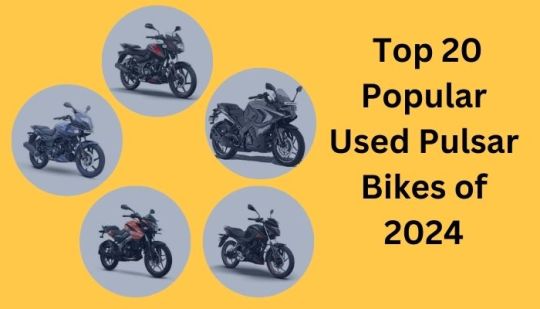
Let's dive into the details and explore the features, specifications, and highlights of these impressive machines.
1. Bajaj Pulsar RS200
Overview:
The Pulsar RS200 is a sporty and aggressive bike designed for thrill-seekers.
Powered by a 199.5cc liquid-cooled engine, delivering 24.5 PS of power and 18.7 Nm of torque.
Features include dual-channel ABS, projector headlamps, and a fully digital instrument cluster.
Perfect for those who crave speed and performance on both city streets and highways.
2. Bajaj Pulsar NS200
Overview:
The Pulsar NS200 is a naked streetfighter with a muscular design and impressive performance.
Equipped with a 199.5cc liquid-cooled engine, producing 24.5 PS of power and 18.5 Nm of torque.
Features a perimeter frame, single-channel ABS, and aggressive styling.
Ideal for riders looking for a sporty yet comfortable ride for daily commuting and weekend adventures.
3. Bajaj Pulsar 220F
Overview:
A classic in the Pulsar lineup, the 220F offers a perfect balance of power and comfort.
Powered by a 220cc oil-cooled engine, delivering 20.93 PS of power and 18.55 Nm of torque.
Features include a semi-faired design, projector headlamps, and a digital-analog instrument cluster.
Known for its smooth performance, ideal for long rides and city cruising alike.
4. Bajaj Pulsar NS160
Overview:
The Pulsar NS160 is a sleek and sporty commuter bike with a hint of aggression.
Comes with a 160.3cc oil-cooled engine, generating 17.2 PS of power and 14.6 Nm of torque.
Features include a muscular tank design, split seats, and stylish graphics.
Perfect for urban commuting with its nimble handling and impressive fuel efficiency.
5. Bajaj Pulsar 150
Overview:
A true icon in the Pulsar family, the Pulsar 150 offers a blend of performance and affordability.
Equipped with a 149.5cc air-cooled engine, producing 14 PS of power and 13.25 Nm of torque.
Features a sporty design, alloy wheels, and comfortable seating for rider and pillion.
Ideal for daily commuting, city rides, and occasional weekend getaways.
6. Bajaj Pulsar 180F
Overview:
The Pulsar 180F is a semi-faired version of the popular Pulsar 180, adding a sporty touch to the design.
Powered by a 178.6cc air-cooled engine, delivering 17.02 PS of power and 14.52 Nm of torque.
Features a stylish fairing, clip-on handlebars, and LED tail lamps.
Offers a perfect balance of performance and comfort for riders seeking a sporty commuter.
7. Bajaj Pulsar NS125
Overview:
The Pulsar NS125 is a compact and agile streetfighter designed for urban commuting.
Comes with a 124.4cc air-cooled engine, generating 12 PS of power and 11 Nm of torque.
Features a muscular tank, split seats, and sharp styling elements.
Perfect for new riders and city dwellers looking for a lightweight and efficient ride.
8. Bajaj Pulsar 135 LS
Overview:
The Pulsar 135 LS is a lightweight and nimble bike with a sporty demeanor.
Equipped with a 134.66cc air-cooled engine, producing 13.56 PS of power and 11.4 Nm of torque.
Features a sharp headlamp design, digital-analog instrument cluster, and stylish decals.
Ideal for urban riders who prioritize agility, fuel efficiency, and easy maneuverability.
9. Bajaj Pulsar RS400 (Concept)
Overview:
The Pulsar RS400, though a concept, promises to be a game-changer in the sportbike segment.
Expected to feature a powerful 373.3cc liquid-cooled engine with impressive performance figures.
Sleek, aerodynamic design with dual-channel ABS, full fairing, and advanced technology.
Anticipated to be the ultimate machine for adrenaline junkies and track enthusiasts.
10. Bajaj Pulsar AS200
Overview:
The Pulsar AS200 is an adventure sportbike designed for both on-road and off-road adventures.
Powered by a 199.5cc liquid-cooled engine, delivering 23.17 PS of power and 18.3 Nm of torque.
Features a semi-faired design, windshield, and comfortable riding posture.
Perfect for riders seeking versatility and excitement in their riding experience.
11. Bajaj Pulsar AS150
Overview:
The Pulsar AS150 offers adventure styling with the convenience of a commuter bike.
Equipped with a 149.5cc air-cooled engine, producing 17 PS of power and 13 Nm of torque.
Features a semi-faired design, projector headlamps, and comfortable seating.
Ideal for riders looking for a sporty commuter with a touch of adventure.
12. Bajaj Pulsar 220 DTS-i
Overview:
A legendary model in the Pulsar lineup, the Pulsar 220 DTS-i continues to impress riders.
Comes with a 220cc oil-cooled engine, delivering 20.93 PS of power and 18.55 Nm of torque.
Features a muscular design, projector headlamps, and digital-analog instrument cluster.
Known for its robust performance, ideal for long rides and spirited cruising.
13. Bajaj Pulsar 200NS
Overview:
The Pulsar 200NS combines performance, style, and affordability into one impressive package.
Equipped with a 199.5cc liquid-cooled engine, producing 23.5 PS of power and 18.3 Nm of torque.
Features a naked streetfighter design with aggressive styling cues.
Comes with features like a perimeter frame, mono-shock rear suspension, and petal disc brakes.
Ideal for riders seeking a thrilling and responsive ride on both city streets and highways.
14. Bajaj Pulsar 180
Overview:
The Pulsar 180 is a time-tested model known for its reliability and performance.
Powered by a 178.6cc air-cooled engine, delivering 17.02 PS of power and 14.22 Nm of torque.
Features a classic Pulsar design with muscular tank, split seats, and alloy wheels.
Perfect for riders looking for a well-rounded bike for daily commuting and occasional rides.
15. Bajaj Pulsar 125 Neon
Overview:
The Pulsar 125 Neon is a stylish and efficient commuter bike with a sporty touch.
Equipped with a 124.4cc air-cooled engine, producing 11.8 PS of power and 10.8 Nm of torque.
Features a neon color scheme, stylish graphics, and comfortable seating.
Ideal for new riders and urban commuters seeking a mix of style, performance, and fuel efficiency.
16. Bajaj Pulsar 220 S
Overview:
The Pulsar 220 S is a variant of the popular 220F with a slightly different design.
Comes with the same 220cc oil-cooled engine, delivering 20.93 PS of power and 18.55 Nm of torque.
Features a sporty yet understated design with a bikini fairing and stylish decals.
Known for its solid performance and comfortable riding posture.
17. Bajaj Pulsar 200 DTS-i
Overview:
The Pulsar 200 DTS-i is a capable and versatile bike designed for various riding styles.
Equipped with a 199.5cc oil-cooled engine, producing 18 PS of power and 17.7 Nm of torque.
Features a muscular design, clip-on handlebars, and digital-analog instrument cluster.
Perfect for riders looking for a blend of power, agility, and comfort on the road.
18. Bajaj Pulsar 135
Overview:
The Pulsar 135 is a compact and lightweight bike with a sporty attitude.
Comes with a 134.66cc air-cooled engine, delivering 13.56 PS of power and 11.4 Nm of torque.
Features a sharp and edgy design with a sporty fairing and aggressive headlamp.
Ideal for city riders and beginners seeking a stylish yet easy-to-handle bike.
19. Bajaj Pulsar 180 DTS-i
Overview:
The Pulsar 180 DTS-i is a popular choice among riders looking for a reliable commuter with a sporty edge.
Powered by a 178.6cc air-cooled engine, producing 16.78 PS of power and 14.22 Nm of torque.
Features a classic Pulsar design with aggressive tank shrouds and stylish graphics.
Known for its smooth performance and comfortable riding posture.
20. Bajaj Pulsar 200 NS FI
Overview:
The Pulsar 200 NS FI is the fuel-injected version of the popular Pulsar 200 NS.
Equipped with a 199.5cc liquid-cooled engine, delivering 24.5 PS of power and 18.6 Nm of torque.
Features a naked streetfighter design with sharp lines and aggressive styling.
Offers precise fuel delivery, improved throttle response, and enhanced performance.
Tips Before Buying a Used Pulsar
Thinking of purchasing a used Bajaj Pulsar motorcycle? Whether you're a seasoned rider or a newcomer to the world of biking, buying a pre-owned Pulsar requires careful consideration to ensure you get a reliable and value-for-money ride. Here are some essential tips to keep in mind before sealing the deal on your used Pulsar purchase:
1. Research the Model:
Before diving into the market, research the specific Bajaj Pulsar model you're interested in. Learn about its specifications, features, pros, and cons.
Understanding the model's strengths and weaknesses will help you make an informed decision based on your preferences and requirements.
2. Set a Budget:
Determine your budget for buying a used Pulsar, taking into account not just the purchase price but also additional expenses like registration, insurance, and potential repairs.
Having a clear budget in mind will help narrow down your options and prevent overspending.
3. Check the Bike's Condition:
A thorough physical inspection is crucial when buying a used motorcycle. Look for any signs of wear, rust, or damage on the body, frame, engine, and suspension.
Pay attention to the tires, brakes, chain, sprockets, and exhaust system for any indications of poor maintenance or neglect.
4. Test Ride the Bike:
Always take the Pulsar for a test ride before finalizing the purchase. This will allow you to assess its performance, handling, and overall condition.
Test the brakes, clutch, throttle response, and suspension on various road surfaces to ensure everything is functioning smoothly.
5. Verify Service History:
Ask the seller for the bike's service records and maintenance history. A well-documented service history indicates that the bike has been cared for and serviced regularly.
Look for evidence of routine oil changes, filter replacements, and other scheduled maintenance tasks.
6. Check Legal Documents:
Verify all legal documents related to the bike, including the registration certificate (RC), insurance papers, pollution under control (PUC) certificate, and NOC (if applicable).
Ensure that the seller has clear ownership of the bike and that all documents are up to date and in order.
7. Mileage and Usage:
Consider the mileage on the used Pulsar as it reflects the bike's wear and tear. Lower mileage bikes generally have less mechanical stress and may be in better condition.
Also, inquire about the type of usage the bike has seen, such as city commuting, highway touring, or occasional rides.
8. Look for Modifications:
Check if the Pulsar has undergone any aftermarket modifications or alterations. While some modifications enhance performance or aesthetics, others may cause reliability issues.
Ensure that any modifications are done professionally and do not compromise the bike's safety or integrity.
9. Research Market Prices:
Compare prices of similar used Pulsar models in the market to gauge a fair and competitive offer.
Online classifieds, dealership listings, and motorcycle valuation tools can provide valuable insights into prevailing market prices.
10. Consider Warranty and Insurance: - Inquire if the used Pulsar bike comes with any remaining warranty from the manufacturer or dealership. - Explore insurance options for the bike, comparing quotes from different providers to get the best coverage at an affordable premium.
11. Bring Along a Mechanic or Expert: - If you're not familiar with motorcycle mechanics, consider bringing along a knowledgeable friend, mechanic, or bike expert when inspecting the Pulsar. - Their expertise can help identify potential issues, assess the bike's overall condition, and provide valuable advice on the purchase.
12. Negotiate Wisely: - Be prepared to negotiate the price based on the bike's condition, market value, and any additional factors you've identified during inspection. - Point out any flaws or needed repairs and use them as leverage for a better deal that aligns with your budget.
13. Trust Your Instincts: - Last but not least, trust your instincts when making the decision to buy. If something feels off or too good to be true, take a step back and reassess. - Don't rush into a purchase; take your time to ensure you're getting a used Pulsar bike that meets your expectations and provides reliable performance.
Conclusion:
The Bajaj Pulsar lineup continues to impress with its wide range of models, each catering to different riding styles and preferences. Whether you're a speed enthusiast, a daily commuter, or an adventure seeker, there's a Pulsar bike that fits your needs.
Before purchasing a used Pulsar bike, it's essential to consider factors such as the bike's condition, mileage, service history, and legal documents. A thorough inspection and test ride will help ensure that you're getting a reliable and well-maintained machine.
With the top 20 used Pulsar bikes of 2024 listed above, you have a comprehensive guide to some of the best models available in the market. Whether you opt for the sporty RS200, the versatile NS200, or the classic 220F, you're sure to enjoy the thrilling performance and stylish design that Pulsar bikes are known for.
So, gear up, hit the road, and experience the excitement of riding one of these iconic machines. Whether you're navigating city streets, cruising on the highway, or exploring off-the-beaten-path trails, a used Pulsar bike promises an exhilarating and unforgettable ride. Happy riding!
FAQs about Buying Used Pulsar Bikes
1. Are used Pulsar bikes reliable?
Yes, used Pulsar bikes are known for their reliability and durability. Bajaj Pulsar motorcycles have a reputation for robust engineering, solid build quality, and dependable performance. When properly maintained, a used Pulsar bike can offer many years of trouble-free riding experience.
2. What factors should I consider when buying a used Pulsar bike?
Several factors should be taken into account when purchasing a used Pulsar bike:
Condition: Thoroughly inspect the bike for any signs of wear, damage, or rust.
Service History: Check the maintenance records to ensure the bike has been regularly serviced.
Mileage: Consider the mileage on the bike as an indicator of its usage and overall wear.
Ownership History: Verify the bike's ownership history to ensure there are no legal or financial issues.
Modifications: Check for any aftermarket modifications or alterations made to the bike.
Market Price: Research the market value of the specific model to ensure a fair price.
3. Which Pulsar model is best for city commuting?
For city commuting, the Bajaj Pulsar 150, Pulsar 125 Neon, and Pulsar 135 are popular choices. These bikes offer a good balance of fuel efficiency, maneuverability, and comfort, making them ideal for navigating through traffic and city streets.
4. Is it better to buy a newer model or an older model with lower mileage?
The decision between a newer model and an older model with lower mileage depends on your preferences and budget. A newer model may come with updated features and technologies, but it can also be more expensive. On the other hand, an older model with lower mileage may offer good value for money, provided it has been well-maintained.
5. What is the average mileage I can expect from a used Pulsar bike?
The mileage of a used Pulsar bike can vary depending on factors such as the model, engine condition, riding style, and maintenance. On average, you can expect mileage ranging from 40 km/l to 60 km/l, with some models offering even higher fuel efficiency.
6. How do I ensure that the used Pulsar bike I'm buying is in good condition?
To ensure the bike is in good condition:
Inspect Thoroughly: Check for any signs of wear, rust, or damage on the body, engine, and chassis.
Test Ride: Take the bike for a test ride to assess its performance, handling, and comfort.
Engine Sound: Listen for any unusual sounds or vibrations from the engine.
Brake and Suspension: Test the brakes and suspension for responsiveness and smooth operation.
Service Records: Review the bike's service history and maintenance records.
Consult a Mechanic: If unsure, have a trusted mechanic inspect the bike for any hidden issues or concerns.
7. Are spare parts readily available for used Pulsar bikes?
Yes, Bajaj Pulsar Bikes has a wide network of authorized service centers and dealerships, making spare parts readily available. You can easily find genuine parts for routine maintenance and repairs.
8. Can I get insurance for a used Pulsar bike?
Yes, insurance is available for used Pulsar bikes. Many insurance providers offer comprehensive coverage, third-party liability, and add-on options such as zero depreciation and roadside assistance. It is recommended to insure your bike for financial protection against accidents and damages.
9. What are some common maintenance tasks for Pulsar bikes?
Common maintenance tasks for Pulsar bikes include:
Regular Servicing: Oil changes, filter replacements, and overall tune-ups.
Chain Maintenance: Lubrication and tension adjustment for smooth operation.
Brake Inspection: Checking brake pads, fluid levels, and brake system performance.
Tire Care: Monitoring tire pressure, tread wear, and alignment for safe handling.
Electrical Checks: Ensuring lights, indicators, and electrical components are functioning properly.
10. Can I customize a used Pulsar bike?
Yes, Pulsar bikes offer a range of customization options for riders who want to personalize their ride. From aftermarket exhaust systems and performance upgrades to cosmetic changes such as decals and paint jobs, you can customize your Pulsar bike to suit your style and preferences.
11. How can I negotiate the price when buying a used Pulsar bike?
To negotiate the price effectively:
Research Market Value: Know the market value of the specific model and year.
Highlight Imperfections: Point out any flaws or issues during the inspection.
Compare Prices: Compare prices from different sellers to gauge a fair offer.
Be Prepared to Walk Away: Don't hesitate to walk away if the seller isn't willing to negotiate.
Negotiate Extras: Negotiate for extras such as warranty, servicing, or accessories included in the deal.
12. Are there any specific models of used Pulsar bikes recommended for long-distance touring?
Yes, several Pulsar models are well-suited for long-distance touring due to their comfort, performance, and reliability. Some popular choices include the Pulsar 220F, Pulsar RS200, and Pulsar NS200. These bikes offer a comfortable riding posture, ample power for highway cruising, and fuel efficiency for long rides.
13. What should I do if I encounter problems with my used Pulsar bike after purchase?
If you encounter any issues with your used Pulsar bike: -
Warranty Check: Check if the bike is still under warranty for covered repairs.
Authorized Service Center: Visit an authorized Bajaj service center for professional diagnosis and repairs.
Consult a Mechanic: If the bike is out of warranty, consult a trusted mechanic for expert advice and repairs.
14. Can I find used Pulsar bikes with advanced features and technology?
Yes, newer models of Pulsar bikes come equipped with advanced features such as ABS (Anti-lock Braking System), digital instrument clusters, fuel injection systems, and LED lighting. When buying a used Pulsar bike, you can find models with these modern technologies for added convenience and safety.
15. Where can I browse and purchase used Pulsar bikes?
You can browse and purchase used Pulsar bikes from various sources:
Online Classifieds: Websites like OLX, Quikr, and BikeWale offer a wide selection of used bikes for sale.
Authorized Dealerships: Bajaj's certified pre-owned dealerships provide quality assurance and warranty options for used Pulsar bikes.
Local Dealerships: Many local Bajaj dealerships also offer a range of inspected and certified used bikes for purchase.
0 notes
Text
Review, teardown, and testing of LRS-150-24 Mean Well power supply

The LRS-150-24 power supply can operate from a 100–120 volt or 200–240 volt AC network. The manufacturer states it provides an output current of up to 6.5 amperes at 24 volts. The supply measures 5¾ × 3¾ × 1¼ inches (145 × 95 × 30 millimeters), made on a fiberglass printed circuit board fixed to the base's case. The top cover is perforated in a honeycomb pattern. The case and cover are both made of aluminum.
The board is put together neatly, with no visible defects. The components are arranged evenly, and soldering was done with a no-clean flux. Absolutely nothing dangles or rattles in the assembly.
No noises of any sort were noticed during the operation of the power supply.
The power supply uses a flyback circuit without PFC.

The input voltage is supplied to the input node: RF interference filter (1), a pulse surge limiter (varistor), then the voltage goes to the diode bridge (2) and two input electrolytic capacitors (3). The input voltage selector is also located here. Flyback, built on a MW03A controller (4, installed on the back side of the board) and a power switch (5) on a N-channel MOSFET transistor MMF60R290P. Unfortunately, there is no information about the controller on the Internet. The transistor has a channel resistance of 0.29 ohms at 650 volts and 13 amps. The transformer (6) is entirely covered by the casing, so it is unclear what core material is used. The output rectifier (7) is built using a Schottky diode HBR20150 in a TO-220F package screwed to the side wall and covered with casing. It is basically dual 150V 10A diodes connected in parallel. After the diode there are four output electrolytic capacitors (8) and an additional LC filter. Here (12), there is a small output voltage indicator (green LED) and a regulator (tuning resistor) for adjusting the output voltage. Input and output circuits are connected through a shared screw 7-terminal block (10). 3 terminals for the input line, neutral, and ground wires, and 2 in parallel for common and +24V output.
The main electrolytic capacitors are designed for operating temperatures up to 220°F (105°C), Rubycon. Two optocouplers (11) are installed in the feedback circuit, most likely with phototransistors transmitting control signals from the low-voltage output to the high-voltage input side.
The board has a few cutouts to increase the dielectric strength between the high-voltage and low-voltage sides of the circuit.
The picture shows that the board has three unused spots for storage output capacitors (8), most likely used in the other power supplies of the same series but with different output voltages.
Test conditions
Most tests use metering circuit #1 (see appendices) at 80°F (27°C), 70% relative humidity, and 29.8 inHg pressure.
The measurements were performed without preheating the power supply with a short-term load unless mentioned otherwise.
The following values were used to determine the load level:

Output voltage under a constant load

The high stability of the output voltage should be noted.
Power-on parameters
Powering on at 100% load
The power supply is turned off at least 5 minutes before the test, with a 100% load connected.
The oscillogram of switching to a 100% load is shown below (channel 1 is the output voltage, and channel 2 is the current consumption from the grid):

The picture shows three distinguishable phases of the power-on process:
The pulse of the input current charging the input capacitors when connected to the grid has an amplitude of about 7.5 A and a duration of 2 ms.
Waiting for the power supply control circuit to start for about 100 ms.
(Output Voltage Rise Time) Starting the converter, increasing the output voltage, and entering the operating mode) is 8 ms.
(Turn On Delay Time) The entire process of entering the operating mode from the moment of powering on) is 119 ms.
(Output Voltage Overshoot) Output voltage overshoot is absent; the switching process is aperiodic.
Powering on at 0% load
The power supply is turned off at least 5 minutes before the test, with a 100% load connected. Then, the load is disconnected, and the power supply is switched on.
The oscillogram of switching to a 0% load is shown below:
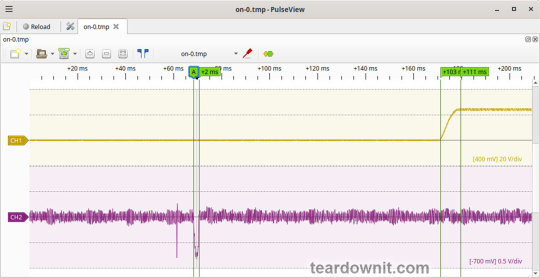
The picture shows three distinguishable phases of the power-on process:
The pulse of the input current charging the input capacitors when connected to the grid has an amplitude of about 7 A and a duration of 2 ms.
Waiting for the power supply control circuit to start for about 103 ms.
(Output Voltage Rise Time) Starting the converter, increasing the output voltage, and entering the operating mode) is 8 ms.
(Turn On Delay Time) The entire process of entering the operating mode from the moment of powering on) is 111 ms.
(Output Voltage Overshoot) Output voltage overshoot is absent; the switching process is aperiodic.
Power-off parameters
The power supply was turned off at 100% load, and the input voltage was nominal at the moment of powering off. The oscillogram of the shutdown process is shown below:

The picture shows two phases of the shutdown process:
(Shut Down Hold Up Time) The supply continues to operate due to the input capacitors holding charge until the voltage across them drops to a certain critical level at which maintaining the output voltage at the nominal level becomes impossible is 31 ms.
(Output Voltage Fall Time) Reduction of the output voltage, stopping voltage conversion, and accelerating the voltage drop is 21 ms.
(Output Voltage Undershoot) Output voltage undershoot is absent, and the shutdown process is aperiodic.
Ripple voltage and current
100% load
The diagram of the current draw from the grid at 100% load is shown in the oscillogram below. The amplitude of the current is about 7.5 A:
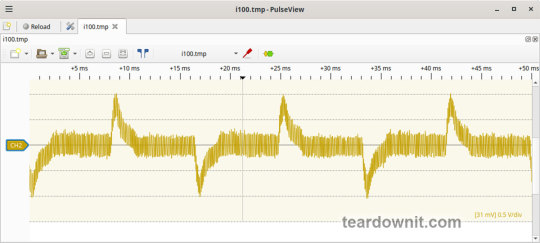
Low-frequency output voltage ripple is under 30 mV (see the oscillogram below):

Output voltage ripple at the converter frequency is under 30 mV (see the oscillogram below):

75% load
Output voltage ripple at the converter frequency is under 30 mV (see the oscillogram below):
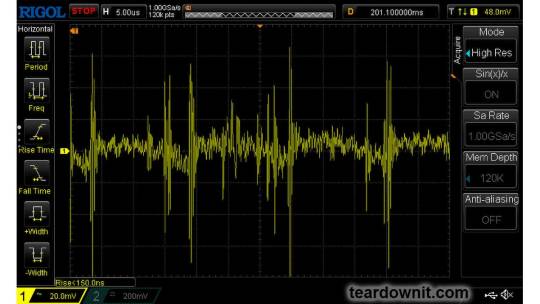
Low-frequency output voltage ripple is under 30 mV (see the oscillogram below):

50% load
Output voltage ripple at the converter frequency stays below 10 mV; see the oscillogram (11):
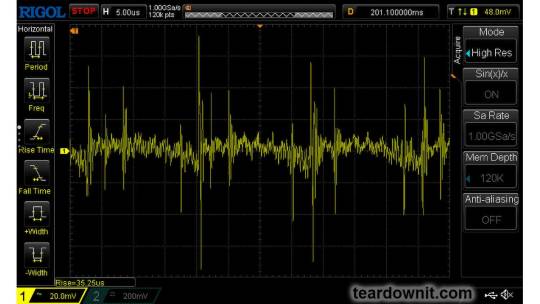

10% load


0% load
No-load current consumption was measured with a multimeter, which is 60 mA RMS.
(Power Consumption) The first assumption of excessive standby power draw of more than 7 W is wrong since the current in this mode is predominantly reactive. Indeed, the input filter in the circuit contains two capacitors with a capacitance of 0.68 μF each; these low-frequency capacitors are connected in parallel, i.e., an equivalent capacitance of 1.36 μF is connected to the input terminals. A simple calculation shows that the current through these capacitors should be equal to Ic=120×2×pi×60×1.36e-6=61.5 mA. A slight difference from the measured value can be explained by the deviation of the actual parameters from their nominal values and measurement error.
Measuring the exact active power consumption at a 0% load with a basic set of instruments (oscilloscope, multimeter, etc.) is impossible.
Output voltage ripple at the converter frequency is under 20 mV (see the oscillogram below):

The amplitude of low-frequency output voltage ripples is about 25 mV (see the oscillogram below):

Dynamic characteristics
A mode with periodic switching between 50% and 100% load was used to evaluate the dynamic characteristics. The process oscillogram is shown below (17):

It is evident that the supply’s response to loading changes is close to aperiodic, and there is no overshoot, which indicates a good stability margin. The magnitude of the response to load changes is within 200 mV.
Overload protection
The claimed protection type is "hiccup mode, recovers automatically after fault condition is removed". This was confirmed during testing. When a short circuit occurs, the power supply periodically tries to turn back on and, if the overload is still present, turns off again until the next attempt. This operating mode reduces energy losses and heating during overload. Still, it does not allow the parallel connection of multiple power supplies with a common output.
The output current for the overload protection to kick in is 8.5 A.
Input circuit safety assessment
(Input discharge) Safety assessment is based on the discharge time constant of the input circuits when disconnected from the grid; the value is 0.384 s. This means that when operating on a 120 V input voltage, the time required to discharge the input circuits to safe values (<42 V) will be 0.61 s:

Important: The result is valid for this particular power supply unit; it was obtained for testing purposes and should not be taken as a safety guarantee.
Thermal modes
When operating with no load connected, no component overheating had been noticed.
When operating under load, the input diode bridge heats up most noticeably.
With a load of 90% and the top cover closed, the case heats up to approximately 200°F; the hottest spot is located in the area of the diode bridge rectifier.
With a load of 95% and the lid closed, the case temperature reaches 230°F:
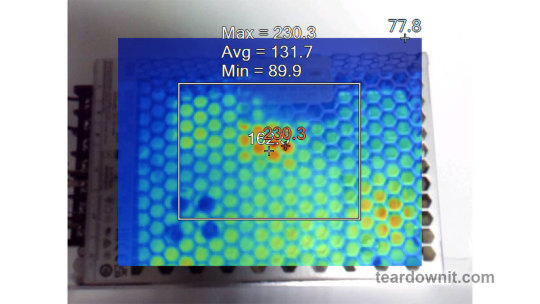
The temperature of the bridge rectifier itself is a dangerous 250°F:
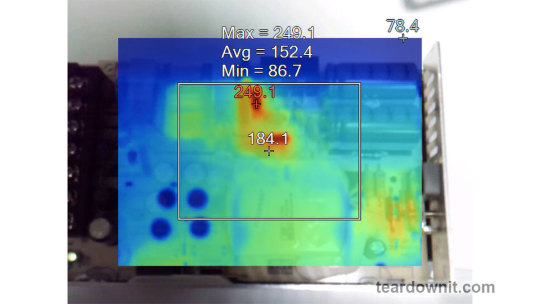
Somewhere around these load values, the power supply goes into a pulse-power-limiting mode and remains in this state either until the load drops or until it cools down. Then this 'heat up', 'limit power', 'cool down', and 'turn back on' cycle repeats.
Other things to consider:
Hot summer weather will decrease the maximum sustainable power output this supply can provide even more.
The tests were conducted with unobstructed air access to the housing for cooling; any changes may increase the heating.
This means that the power supply cannot handle its rated load for a prolonged period with no forced ventilation, and the load should be limited to 5.5 or even 5.0 A.
Conclusions
The reviewed power supply unit has characteristics generally consistent with those declared by the manufacturer, except for the long-term output power, which should be around 120 W.
The build quality is decent; no components clearly unsuitable for the general application, power draw, current, voltage, or temperature were found in the circuit.
The stability of the output voltage should be especially noted.
0 notes